Filter

Location
- New York, USA
Job Type
- Office Based
Filter

Location
- New York, USA
Categories
- Notice
- Pinned


Thursday 1st May 2025

By Alexander Bradford
At Gander & White we proactively seek to place sustainability at the centre of everything we do whenever reasonably possible; in an industry that is constantly evolving, but does not yet readily lend itself to sustainability, our tried and tested motto is to do what we can, where we can. One area that is undergoing notable transformation is the logistics of shipping artworks to major international art fairs like Art Basel and Frieze. As art fairs continue to grow, so too does the environmental impact of transporting fragile artworks around the globe to their respective host cities. The need for sustainable practices in the shipping of these works is becoming not only an ethical necessity but a critical element of the broader conversation on sustainability in the art world.
The Environmental Impact of Art Fair Logistics
Art fairs inherently rely on the transportation of highly valuable and delicate objects from galleries around the globe, but also thereafter the onward journey of these objects to buyers and collectors around the globe. Whether it’s an ancient sculpture or a contemporary painting, each piece requires careful packing, climate control, and secure transportation, all of which has a significant impact on our carbon footprint. From the carbon emissions generated by air and sea freight to the use of single-use packaging materials, the emissions involved in art shipping rapidly add up.
International art fairs, such as Frieze New York which will open at The Shed next month, are among the largest and most prestigious events in the global art market, but also the most environmentally demanding, and so we at Gander & White must find new and innovative ways to fulfil their requirements in a more sustainable way.
A Shift Towards Sustainable Practices
Across all our projects, including the energy-intense art fair cycle, we have implemented several key initiatives to embrace sustainable shipping practices:
Conclusion
Sustainable fine art shipping solutions are now a necessity. By investing in reusable crates and electric vehicles, offering consolidated sea freight services, and through regular analysis of our operations, the fine art logistics industry can contribute to a more sustainable future. Gander & White remains the only global asset-based fine art shipper to have active membership of the GCC (Gallery Climate Coalition), and we continue to put sustainability at the heart of our decision-making. As art fairs multiply in number, and grow in size, it is our responsibility to drive change and set a global example for more sustainable practices in the transportation of art.